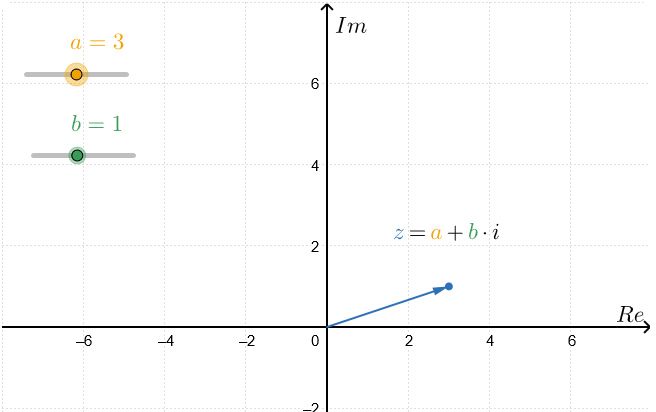Operations with complex numbers: Calculating with complex numbers
 Complex numbers
Complex numbers
Complex numbers are numbers with a general form #\blue{z}=\orange{a} + \green{b}\cdot\complexi# where #\orange a# and #\green b# are real. They form the set #\mathbb{C}# in the same way that real numbers form #\mathbb{R}#, rational numbers form #\mathbb{Q}#, integers #\mathbb{Z}#, and natural numbers #\mathbb{N}#.
The Cartesian or standard form of a complex number #\blue{z}# is \[\blue{z}=\orange{a} + \green{b}\cdot\complexi\] where #\orange a# and #\green b# are real numbers.
A complex number has both a real part, denoted #\mathrm{Re}(z)#, and an imaginary part, denoted #\mathrm{Im}(z)#. \[\begin{array}{rcl}\mathrm{Re}(\blue z) &=& \orange{a}\\ \mathrm{Im}(\blue z) &=& \green{b}\end{array}\]
#\blue{z}# is purely imaginary if #\orange{a}=0# and #\green{b} \neq 0#
#\blue z# is real if #\green{b}=0#.
Examples
\[\begin{array}{rcl}
\blue{z} &=& \orange{1}+\green{\sqrt{2}} \cdot \ii \\
\blue{z} &=& \orange{-\frac{1}{2}}+\green{4} \cdot \ii
\end{array}\]
#\phantom{empty}#
\[\begin{array}{rcl}\blue{z} &=& \orange{-2}\green{-5} \cdot \ii \\
\mathrm{Re}(\blue z) &=& \orange{-2}\\ \mathrm{Im}(\blue z) &=& \green{-5}\end{array}\]
#\phantom{empty}#
\[\begin{array}{rcll}
\blue{z}&=&\green{7}\cdot \ii & \text{is purely imaginary} \\
\blue{z} &=& \orange{6} & \text{is real}
\end{array}\]
We can thus see that the set of real numbers #\mathbb{R}# is contained in the set of complex numbers #\mathbb{C}#, i.e., every real number can be represented by a complex number where #\green{b}=0#.
The set of all complex numbers #\mathbb{C}# can be represented by a two-dimensional plane with the horizontal axis corresponding to the real part of the complex numbers, while the vertical corresponds to their imaginary part. This is the so-called Argand diagram.
Let #\blue{z}= \orange{a} + \green{b}\cdot\complexi#. In the Argand diagram, this number is represented by a vector whose endpoint (the arrowhead) has coordinates #\rv{\orange{a},\green{b}}#. In other words, the horizontal axis indicates the real part of a complex number, while the vertical one indicates its imaginary part.
The real part of a complex number #z = a + b\cdot \ii# is #a#. In this case, #a=9#.

Or visit omptest.org if jou are taking an OMPT exam.




